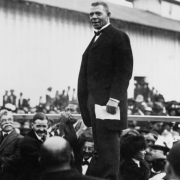In 2010, the National Governors Association established The Common Core State Standards Initiative. Its goal was to set consistent standards for achievement in English and math for each grade in public schools across America. Theoretically, this would better prepare students for success in two and four year college coursework or workforce advancement. This is based on the following premises – that compulsory public education is morally justified, the 19th century Prussian model for mass indoctrination should be continued, and aspiring to 12th grade academic standards in English and math that are lower than the 6th grade standards of 1920 is a whiz-bang idea.
A truly productive idea would have been for one of these governors to invite her 49 colleagues to watch the 1981 documentary Success! The Marva Collins Approach with her. Here, they would have learned that high quality, life-affirming education starts with one essential ingredient, extraordinary teachers who are driven to succeed. As Poetic Justice Warrior Marva Collins tells us about her teaching philosophy, “Determination and perseverance move the world; thinking that others will do it for you is a sure way to fall.” This is what she expects of herself and her teachers, and it is the example for the self-reliance she teaches her students.
For Whom the Bell Curve Tolls
It is an unassailable fact that education is achieved with willing and active participation by both teachers and students. This is its nature, and as such, it cannot be an entitlement. Learning is not a commodity that can be consumed, it requires active minds. This is why her 1992 book, Ordinary Children, Extraordinary Teachers, a compilation of her writing, speeches, and poetry, starts with teachers. Teacher dedication to excellence is why her results are so extraordinary, and why Common Core is an embarrassing failure. For teachers, Collins explains, it starts within yourself, then the classroom, then the home. Independence is paramount, “We have to lead ourselves instead of looking for others to lead us. If we don’t think for ourselves, others will do our thinking for us.”
Collins began her teaching career in 1957, moved to Chicago in 1959, and took a job as a full-time substitute teacher for Chicago Public Schools. After fourteen years of low learning levels, a rapid decline in the quality of the school system, and the onset of ghettos on Chicago’s west side, she did something radical. Collins founded the Westside Preparatory School in the top floors of a brownstone at 3819 West Adam Street in West Garfield Park. Armed with only $5000 borrowed from her teachers pension and no teaching degree, Collins rejected the bureaucratic methods. Instead, she continued developing the ones that were working for her public school students, the children that had been labeled “learning disabled” and written off.
As Carrie-Ann Biondi writes about this beginning stage of Collins’ teaching breakthrough,
To support her convictions, Collins sought hard data. She administered Stanford-Binet tests, which showed that all of the children improved significantly in reading and math. Indeed, these students performed anywhere from one to four years above their current grade levels.
Nearly twenty years later, the co-author of 1994’s controversial psychology book The Bell Curve, Charles Murray, claimed that the extraordinary results being recorded at Westside Prep “were too good to be true.” The thesis of his book is that cognitive ability predicts socially desirable behavior, and that group differences are better explained by intelligence than socio-economic status. When asked about Collins’ achievement, Murray claimed that her methods were ineffective despite having attempted no research into them. The inherent bigotry of all this caught the attention of Morley Safer at CBS and was included in a 1995 60 Minutes national broadcast.
In contrast, psychologist Edwin Locke, a pioneer of Goal-Setting Theory, has discovered that we create our life’s meaning through free will. We do this by accumulating knowledge and skill, cultivating moral virtues, and building habits of effort and persistence.
Speak Up Honey, You’re Brilliant!
Regarding Murray’s faith in IQ, Locke teaches that high IQ does not equal achievement; highly intelligent people must also work hard to achieve their values. This is consistent with what Collins discovered with the students who “were never taught to read, write, compute, or reason.” She knew that if she didn’t give them a philosophy for living “they will automatically hate themselves.” That philosophy is rational egoism,
Trust yourself. Think for yourself. Act for yourself. Imitation is suicide. Success is not coming to you, you must come to it. You have the choice, the right to choose what kind of person you want to be. You are not in school for your parents, for your teachers, or for anyone else. You are here for yourselves.
Collins led her students to a world outside of their government-induced Garfield Park ghetto. By ditching the look-say public school method for teaching reading, Collins taught her students phonics. Instead of owning a 1500 word vocabulary by fourth grade, Westside Prep students had 24,000 word vocabularies. The 93 basic sounds in the English Language allowed her students to comprehend everything they heard or read, all of the time. Teaching phonics led to spelling, story concepts, and composition. This is an example of the hierarchy of conceptualization that is critical to effective education, and is missing in progressive education curricula like Common Core. Accordingly, she did not teach abstract concepts in isolation, they were given context. As Biondi explains,
During a discussion of Sophocles, the class shifted to Greek and Roman gods, including Jupiter, then to a science lesson on the solar system, and a conversation on astronomers from Ptolemy to Carl Sagan. Collins welcomed this kind of organic discussion, it helped students see the flow of knowledge.
The fourth grade students interviewed in the original 1979 60 Minutes feature were asked who their favorite authors were. Some of the answers were Dostoevsky, Shakespeare, Tolstoy, Chaucer, or Kipling. One learning method was Socratic dialogue, and years later Collins explained that since they’re great at memorizing rap lyrics, Plato becomes easy. Like her contemporary Pygmalion of the Soul,
I’m a teacher. A teacher is someone who leads. There is no magic here. I do not walk on water. I just love children. Just as Michelangelo thought there was an angel locked inside every piece of marble, I think there is a brilliant child locked inside every student.
Like Maria Montessori‘s schools, Collins’s classrooms include students of different ages and levels of cognitive development. It challenges them individually, unlike the one size fits all Common Core nonsense. However, Collins’ motivations are not altruistic,
I do what I do very selfishly. I wanted to create citizens in my own school whom I would want as my neighbors, whom I would want as my friends, whom I would want as my doctors, because they are precise. They take pride in what they do.
Like Harper Lee, Collins knew very well the importance of strong fathers at home. Marva’s read literature, newspapers, and poetry with her every night while growing up in Jim Crow Alabama. In 1981, Cicely Tyson and Morgan Freeman starred in her movie The Marva Collins Story. And as poetic justice would have it, Marva Collins made a brief appearance in Prince’s 1994 music video, The Most Beautiful Girl in the World.
The Christmas season is a celebration of life, and here we celebrate the peace, good will, and benevolence of Poetic Justice Warrior Marva Collins who taught “Peace will always rule the day where reason rules the mind.”













